Abstract
Straightforward regio- and diastereoselective synthesis of bi-spirooxindole-engrafted rhodanine analogs 5a–d were achieved by one-pot multicomponent [3 + 2] cycloaddition (32CA) reaction of stabilized azomethine ylide (AYs 3a–d) generated in situ by condensation of L-thioproline and 6-chloro-isatin with (E)-2-(5-(4-chlorobenzylidene)-2,4-dioxothiazolidin-3-yl)-N-(2-morpholinoethyl)acetamide. The bi-spirooxindole-engrafted rhodanine analogs were constructed with excellent diastereo- and regioselectivity along with high chemical yield. X-ray crystallographic investigations for hybrid 5a revealed the presence of four contiguous stereocenters related to C11, C12, C19 and C22 of the spiro structure. Hirshfeld calculations indicated the presence of many short intermolecular contacts such as Cl...C, S...S, S...H, O...H, N...H, H...C, C...C and H...H interactions. These contacts played a very important role in the crystal stability. The polar nature of the 32CA reaction was studied by analysis of the conceptual DFT reactivity indices. Theoretical study of this 32CA reaction indicated that it takes place through a non-concerted two-stage one-step mechanism associated with the nucleophilic attack of AY 3a to the electrophilic ethylene derivative.
1. Introduction
Rhodanines′ (2-thioxothiazolidin-4-ones) privileged structure has attracted much attention in pharmaceutical and medicinal chemistry [1,2]. These substituted rhodanines have been discovered and reported for several pharmaceutical applications, including topoisomerase II inhibition potency [3]; potential AChE inhibitors [4,5]; HIV-1 integrase inhibitors [6]; anti-cancer agent towards MCF-7 breast cancer cells [7] and anti-diabetic (T2DM) targeting the inhibition of enzymes such as aldose reductase (ALR) [8], α-glucosidase [9], α-amylase [10] and PTP1B enzyme [11], and other therapeutic targets have also been reported, such as antibacterial ones [12]. Chemical modification, structural elucidation and molecular interactions investigations of these compounds are still of high interest.
On the other hand, one-pot multicomponent [3 + 2] cycloaddition (32CA) reaction has been established as a powerful and efficient approach for stereoselective synthesis of the spirooxindole pyrrolidine core structure in a wide range of natural products and pharmaceutical compounds [13,14,15,16,17,18,19]. The key step of this strategy is the generation of azomethine ylides (AYs) which then react with electron-deficient ethylene to produce pyrrolidine-spirooxindole with contiguous stereocenters. These pyrrolidine-spirooxindole molecules in particular have shown a panoply of significant pharmaceutical targets and applications, such as MDM2 inhibitors [20,21,22], anti-cancer treatment [7,23], AChE inhibitors [24,25,26] and prospective activity against SARS-CoV-2 [27]. Structural modifications have emerged as attractive synthetic targets for researchers.
Several representative examples have been reported in the literature disclosing the spirooxindole scaffold, but combination of the rhodanine motif with the spirooxindole hybrid is still less discussed. Knorr, M. and his team reported the synthesis of rhodanine-substituted spiro[pyrrolidine-oxindole] analogs and exploited this rhodanine type as an anti-diabetic agent via inhibition of the α-amylase enzyme [28]. Recently, the research group headed by El-Faham reported the rhodanine subtype carboxamide with a backbone of several amino acids using OxymaPure/N,N′-diisopropylcarbodimide coupling methodology and evaluated these compounds for their antimicrobial activities [29].
Inter- or intramolecular hydrogen bonding interactions were found to play a crucial role in different systems which contribute to the conformational stability of proteins [30] and aid in the dimerization or aggregation of the supramolecular chemistry [31].
Recent advances made in the theoretical understanding of 32CA reactions based on the Molecular Electron Density Theory [32] (MEDT) have allowed for establishing a very good correlation between the electronic structure of the simplest three-atom-components (TACs) and their reactivity towards ethylene [33]. The simplest AY, CH2-NH-CH2, is a very reactive pseudodiradical TAC participating in pdr-type 32CA reactions without any appreciable barrier [34]. However, substitution on the experimental TACs stabilizes them, thus changing the electronic structure and, consequently, the reactivity to that of a zw-type 32CA reaction [35]. Consequently, this type of 32CA reaction demands adequate nucleophilic/electrophilic activation of the reagents to take place [35]. Synthesis of a new ethylene system and its employment for 32CA reaction for the purpose of theoretical study understanding by MEDT are a challenge.
Based on the findings above and continuing in the contribution to the synthesis of new spiro-heterocycle hybrids, in this study we report the straightforward synthesis of rhodanine-substituted spiro[pyrrolidine-oxindole]-carboxamide/morpholine derivatives 5a–d using the 32CA reaction methodology. Thermal prototropy generated the stabilized AYs 3a–d in situ, which then reacted with the rhodanine subtype 4 to produce the desired compounds 5a–d (see Scheme 1). Furthermore, molecular structure and intermolecular interactions, the X-ray crystal structure of 5a, Hirshfeld analysis and conceptual DFT studies at the ground state of the reagents are also discussed.
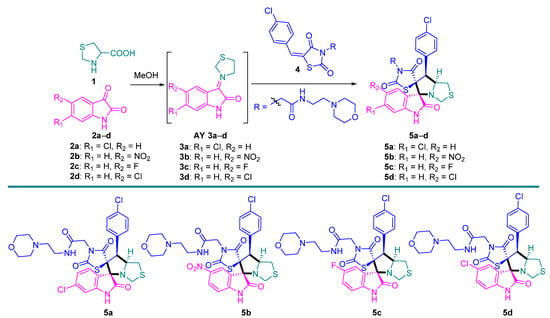
Scheme 1.
Synthesis of compounds 5a–d via 32CA reaction of AYs 3a–d with ethylene derivative 4.
2. Results and Discussion
The straightforward regio- and diastereoselective synthesis of the desired bi-spirooxindole-engrafted rhodanine analogs 5a–d is shown in Scheme 1. The requisite starting material named (E)-2-(5-(4-chlorobenzylidene)-2,4-dioxothiazolidin-3-yl)-N-(2-morpholinoethyl)acetamide 4 was synthesized following the method reported in the literature [29]. Employing the one-pot multicomponent-based 32CA reaction approach of the arylidene rhodanine analog 4 with di-carbonyl compounds (6-chloroisatin 2a; 5-nitroisatin 2b; 5-fluoroisatin 2c; 5-chloroisatin 2d) and thioproline 1 under reflux conditions in MeOH for 2 h produced the target stereoselective bi-spirooxindole-engrafted rhodanine analogs 5a–d. The reaction proceeded initially with isatins 2a–d reacting with the secondary amino acid (L-thioproline) 1 to generate the azomethine ylides in situ (AYs 3a–d). In the second step, the generated azomethine ylides (AYs 3a–d) reacted with the arylidene rhodanine analog 4 with four possible approach modes: two regioisomeric approach modes of the aryl-substituted carbon of 4 to the two carbons of the azomethine ylides (AYs) framework of AYs 3a–d, named ortho and meta, and two stereoisomeric approach modes of the C–C double bond of 4 to AYs 3a–d, named endo and exo. The four possible alternative reaction paths are shown in Scheme 2. The formation of the bi-spirooxindole-engrafted rhodanine analogs 5a–d indicates that this 32CA reaction is completely ortho regioselective and exo stereoselective, taking place via the transition state structure TS-ox. The spectral data of the bi-spirooxindole-engrafted rhodanine analogs 5a–d were assigned and elucidated and were found to be in good agreement with the proposed structure. The chemical structure of 5a was further confirmed by single-crystal X-ray diffraction analysis.
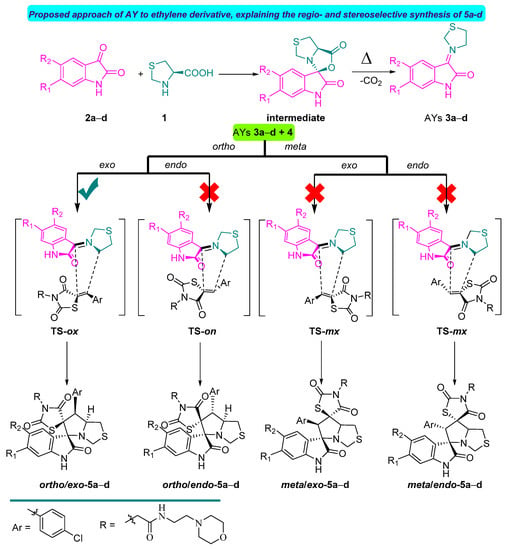
Scheme 2.
Synthesis and plausible mechanism of the desired spirooxindole derivatives 5a–d.
2.1. Crystal Structure Description
The X-ray structure of 5a showing atom numbering and thermal ellipsoids drawn at the 30% probability level is shown in Figure 1. The structure agrees very well with the spectral analyses. The crystal data and structure refinement details are depicted in Table 1, while selected bond distances and angles are listed in Table 2. The compound crystallized in the monoclinic system and P21 space group with unit cell parameters of a = 14.0397(2) Å, b = 15.9918(2) Å, c = 14.1488(2) Å and β = 109.439(2)°. The unit cell volume was 2995.61(8) Å3 and the number of molecules per unit cell was 4. The asymmetric unit comprised two crystallographically independent molecules of 5a and two water molecules. The geometrical parameters of the two units are marginally different. The reported X-ray structure revealed very well the presence of four asymmetric carbon centers in the spiro-system, namely C11, C12, C19 and C22 (Figure 1).
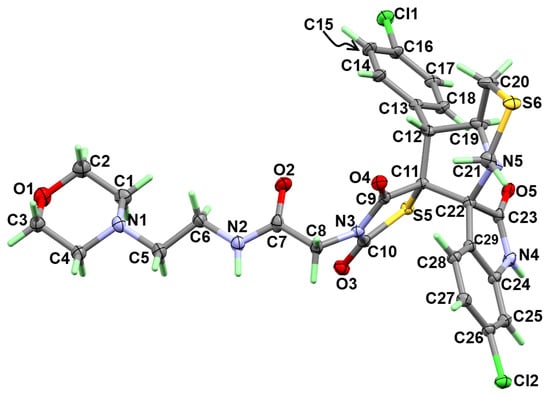
Figure 1.
Atom numbering and thermal ellipsoids at 30% probability level for 5a. Only one unit (unit a) is presented; the second unit and the crystallized solvent molecules are not shown for simplicity.

Table 1.
Crystal data of compound 5a.

Table 2.
Selected bond lengths (Å) and angles (°) for 5a.
The molecules of 5a are connected with each other, including the solvent water, via a complicated set of strong N-H...O, O-H...O and O-H...S hydrogen bonding interactions as well as weak C-H...O interactions (Table 3). The hydrogen bond network is shown in Figure 2.

Table 3.
Hydrogen bonds for 5a (Å and °).
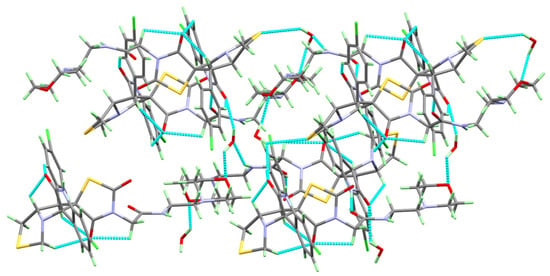
Figure 2.
Packing of molecular units via hydrogen bonding interactions in compound 5a.
2.2. Analysis of Molecular Packing
In light of the great importance of intermolecular interactions for crystal stability, Hirshfeld calculations were employed in order to analyze the molecular packing in the studied system. The Hirshfeld surfaces of 5a are shown in Figure S1 (Supplementary Materials). The crystal structure of 5 indicated the presence of two molecules as an asymmetric unit; hence, the Hirshfeld surfaces of both units are presented in this figure.
In Figure 3, the dnorm maps of both molecules are also presented. The red regions indicate the atomic sites included in strong intermolecular interactions with the neighboring molecules. It is clear that the molecular packing in the studied system is controlled by many short contacts such as Cl...C, S...S, S...H, O...H, N...H, H...C, C...C and H...H interactions.
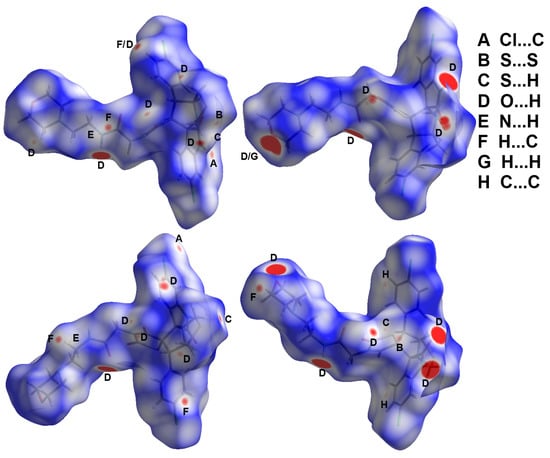
Figure 3.
The dnorm maps of the two molecular units (top: unit A; bottom: unit B) showing the most important contacts in 5a.
In addition, fingerprint plots gave a quantitative summary for all intermolecular interactions. Decomposed fingerprint plots enabled us to calculate the percentage of each intermolecular interaction (Figure 4). The distribution of all possible intermolecular interactions is shown in Figure 5. It is clear that the H...H (38.8%), O...H (19.9%), Cl...H (13.1%) and H...C (9.7%) contacts are the most dominant in molecular unit B in the atom numbering of the heavy atoms (unit B). The results for the other molecular unit (unit A) are almost the same (Table S1, Supplementary Materials).
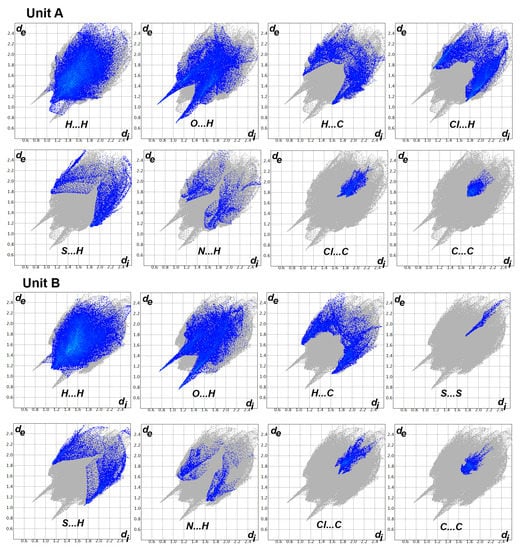
Figure 4.
Decomposed fingerprint plots of the most dominant contacts of 5a.
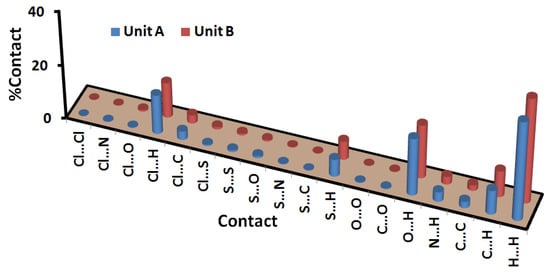
Figure 5.
The percentages of all possible intermolecular interactions in the crystal structure of 5a.
Both the fingerprint plots and dnorm maps provide clear evidence on the short intermolecular interactions which control the crystal stability. Many short O...H interactions occurred in this crystal. A summary of the most important contacts and the corresponding interaction distances is listed in Table 4. The O5B…H1SB (1.974 Å), O2…H5 (1.765 Å), O2B…H5BA (1.941 Å), O2S…H2BA (1.856 Å), O1B…H2S (1.886 Å) and O1S…H2 (1.995 Å) hydrogen bonds are significantly short and hence have great importance in the molecular packing. The two spikes in the decomposed fingerprint plot of the O...H interactions indicate not only strong hydrogen bonds but also the molecule acting as both the hydrogen bond donor and acceptor. In the same table, all contacts with a distance shorter than the vdWs radii sum of the interacting atoms are also presented. The only exception is the N2…H6BA (2.683Å) contact, which has a slightly longer contact distance than the vdWs radii sum of the N and H atoms (2.64 Å).

Table 4.
Important contacts and their interaction distances.
2.3. DFT Studies of the Structure of 5a
The molecular geometry of 5 was calculated and the resulting optimized structure is shown in Figure 6 (right part). As can be seen from Table 5, there are good agreements between the calculated and experimental bond distances. In addition, there are straight-line correlations between the calculated and experimental bond distances (R2 = 0.9932) and angles (R2 = 0.8759), as shown in Figure 7. In addition, the structure matching between the calculated and experimental structures is shown in Figure 6 (left part). Generally, the structural parameters indicate good agreement between the calculated results and X-ray geometry, with some little variations which could be attributed to the packing effects.
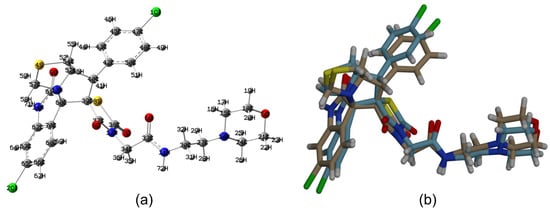
Figure 6.
The optimized geometry (a) and overlay of the optimized geometry with experimental structures (b)for 5a.

Table 5.
The calculated bond distances compared with the experimental data a.
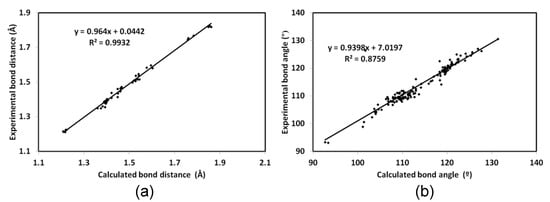
Figure 7.
Correlations between the calculated and experimental (a) bond distances, and (b) bond angles.
The charges at the different atoms of 5 are collated in Table 6. The results indicate the presence of a number of negatively charged atomic sites, including N, O and the majority of C sites. There are five oxygen atoms and five nitrogen sites in 5a where the exo carbonyl oxygen and the neighboring amidic nitrogen atoms are the most negative, respectively. All carbon atoms bonded to N or O atoms have highly positive natural charges. In addition, the NH protons are the most positive hydrogen atoms (0.4475 and 0.4196 e). These results are in good agreement with the molecular electrostatic potential map (MEP) shown in Figure 8. In the MEP, the red colored areas are related to regions of high electron density while the blue colored areas are related to highly electron-deficient regions. The red regions are related to carbonyl oxygen while the blue regions are close to the NH protons. The studied compound has a polar nature with a net dipole moment of 2.5735 Debye, and the direction of the dipole moment vector is shown in Figure 8.

Table 6.
Natural charge (NC) population of 5a a.
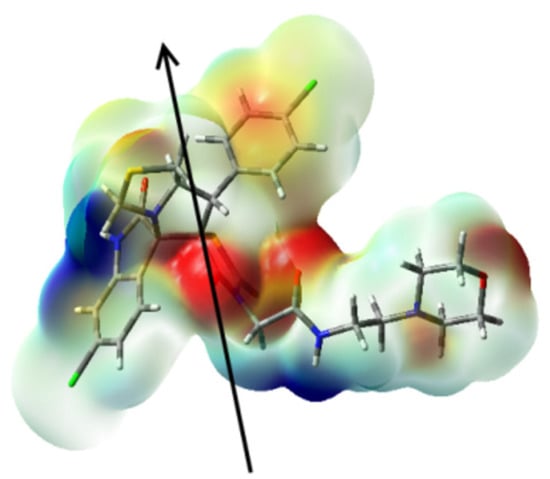
Figure 8.
The MEP of 5a.
2.4. Conceptual DFT Analysis of the 32CA Reaction of AYs 3a–d with Ethylene Derivative 4
The reactivity indices defined within the conceptual DFT (CDFT) [36,37] have been shown to be powerful tools to understand the reactivity in polar reactions. The global reactivity indices, namely the electronic chemical potential μ, chemical hardness η, global electrophilicity ω and global nucleophilicity N, for AYs 3a–d and ethylene 4 involved in this 32CA reaction and the reduced models AY 6 and ethylene 7 are gathered in Table 7.

Table 7.
B3LYP/6-31G(d) electronic chemical potential μ, chemical hardness η, electrophilicity ω and nucleophilicity N, in eV, of AYs 3a–d and 6 and ethylene derivatives 4 and 7.
The electronic chemical potentials [36] μ of AYs 3a–d, ranking from μ = −3.26 (3c) to −3.71 (3b) eV, are higher than that of the ethylene derivative 4, μ = −4.30 eV, indicating that along a polar 32CA reaction, the global electron density transfer (GEDT) [38] will take place from AYs 3a–d to the ethylene derivative 4, with the 32CA reaction being classified as the forward electron density flux (FEDF) [39].
The electrophilicity index ω [40] of AYs 3a–d ranges from 1.62 (3c) to 2.14 (2b) eV, thus being classified as strong electrophiles within the electrophilicity scale [37]. On the other hand, AYs 3a–d present a nucleophilicity index N [41] between 3.79 (3d) and 4.23 (3c) eV, thus being classified as strong nucleophiles within the nucleophilicity scale [37]. The strong nucleophilic character of AYs 3a, 3c and 3d, higher than 4.0 eV, allows for their classification as supernucleophiles [42]. Note that the presence of the strong electron-withdrawing NO2 group in AY 3b markedly increases its electrophilicity index ω to 2.14 eV and decreases its nucleophilicity index N to 3.79 eV. In spite of these behaviors, AY 3b is a very strong nucleophile participating in polar 32CA reactions of FEDF.
The ethylene derivative 4 presents an electrophilicity index ω of 2.51 eV, being classified as a strong electrophile within the electrophilicity scale. On the other hand, it presents a nucleophilicity index N of 3.09 eV, being classified also as a strong nucleophile within the nucleophilicity scale.
The similar electrophilicity ω and nucleophilicity N indices of the reduced models AY 6 and ethylene 7 to those of the experimental AYs 3a–d and ethylene 4 (see Table 7) indicate that the corresponding 32CA reactions will be very similar.
The highly nucleophilic character of AYs 3a–d and 6 together with the strong electrophilic character of the ethylene derivatives 4 and 7 indicate that the corresponding 32CA reactions will have a highly polar character, being classified as FEDF [39].
In a polar reaction involving non-symmetric species, the most favorable reaction path involves the two-center interaction between the most electrophilic and the most nucleophilic centers [43]. Many studies have shown that analysis of the electrophilic Pk+ and nucleophilic Pk− Parr functions [44], resulting from the excess of spin electron density gathered via the GEDT [38], is one of the most accurate and insightful tools for the analysis of the local reactivity in polar and ionic processes. Hence, according to the characteristics of the reagents, the Pk− nucleophilic Parr functions of AY 3a and the Pk+ electrophilic Parr functions of the ethylene derivative 4 were analyzed (see Figure 9).

Figure 9.
B3LYP/6-31G(d) nucleophilic Parr functions, in blue, of AY 3a, and electrophilic Parr functions, in red, of the ethylene derivative 4.
The two carbons of AY 3a are nucleophilically activated by Pk− = 0.35 (C22) and 0.30 (C19), the exocyclic C22 carbon being slightly more activated. Note that the N5 nitrogen is deactivated by Pk− = −0.11. On the other hand, the conjugated C12 carbon of the ethylene derivative 4 is electrophilically activated, Pk+ = 0.30, while the exocyclic C11 carbon in marginally electrophilically activated, Pk+ = 0.09.
Analysis of the Parr functions suggest that the meta reaction paths will be slightly more favorable than the ortho ones. However, steric hindrances present along then meta reaction paths will be responsible of the meta regioselectivity experimentally observed. These steric hindrances can also explain that the ortho/exo reaction path will be favored with respect to the ortho/endo one.
2.5. Study of the Reaction Mechanism
For the study of the mechanism of the 32CA reactions of AYs 3a–d with ethylene 6, a reduced model was selected (see Scheme 3). In this reaction model, the substituents present at the aromatic ring of AYs 3a–d were removed, while the chain present at the amide N3 nitrogen of the ethylene derivative 4 was replaced by a methyl group in ethylene 7. Analysis of the CDFT indices of AY 6 and ethylene 7 showed that they have a similar nucleophilic and electrophilic character compared to the experimental AYs 3a–d and ethylene 4, indicating that the former will present a similar reactivity (see Table 7). Analysis of the reaction path indicated that this 32CA reaction takes place though a one-step mechanism. The B3LYP/6-31G(d) relative energies are given in Scheme 3. The activation energy associated to this 32CA reaction is 8.6 kcal·mol−1, with the reaction being exothermic by −21.7 kcal·mol−1.
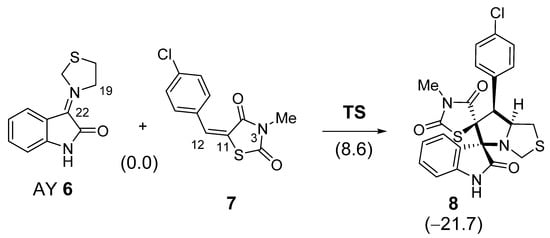
Scheme 3.
The 32CA reaction of AY 6 with the ethylene derivative 7. Relative energies, with respect to separated reagents, are indicated in parentheses in kcal·mol−1.
The geometry of the transition state structure TS is given in Figure 10. The C–C distances between the two pairs of interacting carbons are 2.116 (C12–C19) and 2.875 (C11–C22) Å. These distances indicate that this TS is associated with a highly asynchronous C–C single-bond formation process, in which the shorter C12–C19 distance corresponds to that involving the most electrophilic carbon C12 of the ethylene derivative 7. These C–C distances, which are higher than 2.1 Å, indicate that the formation of the two C–C single bonds had not begun at the TS [38]. Analysis of the intrinsic reaction coordinates [45] associated to the highly asynchronous TS indicated that this 32CA reaction takes place through a non-concerted two-stage one-step mechanism [46] in which formation of the second C11–C22 single bond begins when the first C12–C19 single bond is completely formed.
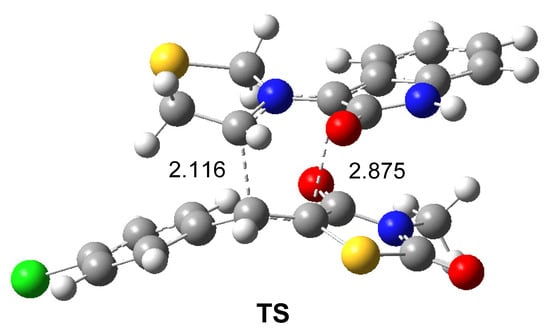
Figure 10.
B3LYP/6-31G(d) geometry of TS. The distances are given in Angstrom.
Finally, analysis of the GEDT [38] at the TS allowed for assessment of the polar character of this 32CA reaction. GEDT values lower than 0.05 e correspond with non-polar processes, while values higher than 0.20 e correspond with polar processes. The GEDT value at the TS was 0.26 e. This high GEDT value is a consequence of the supernucleophilic character of AY 6 and the strong nucleophilic character of ethylene 7. The flux of the electron density, which goes from AY 6 to ethylene 7, classifies this 32CA reaction as FEDF, in clear agreement with the analysis of the CDFT indices.
3. Materials and Methods
3.1. General Notes
Isatin derivatives 2a–d and thioproline 1 are commercially available (Sigma-Aldrich Chemie GmbH, Riedstr, Germany; and Alfa Aesar GmbH & Co KG, Karlsruhe, Germany). 1H-NMR and 13C-NMR spectra were recorded in DMSO-d6 (Jeol Spectrometer (400 MHz), (Jeol, Tokyo, Japan). X-ray diffraction data were collected on a Rigaku Oxford Diffraction Supernova diffractometer and processed with CrysAlisPro software v. 1.171.41.93a (Rigaku Oxford Diffraction, Yarnton, UK, 2020) using Cu Kα radiation.
3.2. Synthesis of Compound 4
The desired starting material 4 was synthesized according to the reported literature [29].
3.3. General Method for the Synthesis of 5a–d
A mixture of three components including isatin derivatives 2a–d (0.5 mmol), L-thioproline 1 (66.5 mg, 0.5 mmol) and the compound 4 (204.5 mg, 0.5 mmol) was refluxed in an oil bath for 2 h. After completion of the reaction as evident from tlc (TLC Eluent: Ethyl acetate: n-Hexane 40%), the reaction mixture was kept at room temperature overnight for slow evaporation, and the solid crystalline materials were filtered off to obtain compounds 5a–d without any further purification as faint yellow solid compounds with 80–90% chemical yield.
- 2-((3S,6′S,7′S,7a′S)-6-chloro-7′-(4-chlorophenyl)-2,2″,4″-trioxo-7′,7a′-dihydro-1′H,3′H-dispiro[indoline-3,5′-pyrrolo[1,2-c]thiazole-6′,5″-thiazolidin]-3″-yl)-N-(2-morpholinoethyl)acetamide 5a
According to the general method, the 6-chloro-isatin 2a (90.5 mg, 0.5 mmol) was utilized and the final compound 5a was obtained as a faint yellow solid compound with 85% chemical yield.
1H-NMR (400 Hz, DMSO-d6): δ 11.17 (s, 1H, NH), 8.06 (t, J = 5.6 Hz, 1H, NHCO), 7.48 (d, J = 8.2 Hz, 2H, C6H4), 7.41 (d, J = 8.2 Hz, 2H, C6H4), 7.26 (d, J = 8.2 Hz, 1H, C6H3 (oxindole)), 7.07 (d, J = 10.2 Hz, 1H, C6H3 (oxindole)), 6.90 (s, 1H, C6H3 (oxindole)), 4.85 (q, J = 6.9 Hz, 1H), 4.18 (d, J = 9.4 Hz, 1H), 3.97 (q, J = 5.4 Hz, 2H), 3.82 (d, J = 6.2 Hz, 1H), 3.56 (d, J = 4.5 Hz, 4H), 3.46 (d, J = 6.0 Hz, 1H), 3.19–3.13 (m, 2H), 3.02 (q, J = 5.5 Hz, 1H), 2.77 (d, J = 7.8 Hz, 1H), 2.37–2.30 (m, 6H); 13C-NMR (100 Hz, DMSO-d6): δ 176.2, 174.7, 168.7, 164.7, 158.3, 154.7, 151.3, 145.4, 135.9, 135.6, 133.4, 132.3, 131.5, 129.1, 121.6, 110.8, 76.2, 75.5, 70.1, 66.7, 57.7, 55.9, 53.8, 47.1, 43.9, 36.7, 33.3; Chemical Formula: C29H29Cl2N5O5S2; LCMS (m/z): 662.18 [M + H]+; Elemental Analysis: [Calculated: C, 52.57; H, 4.41; N, 10.57; S, 9.68; Found: C, 52.61; H, 4.40; N, 10.69; S, 9.79]. IR (KBr, cm−1): 3424, 3289, 3081, 2928, 2857, 1710, 1620, 1564, 1229, 1139.
- 2-((3S,6′S,7′S,7a′S)-7′-(4-chlorophenyl)-5-nitro-2,2″,4″-trioxo-7′,7a′-dihydro-1′H,3′H-dispiro[indoline-3,5′-pyrrolo[1,2-c]thiazole-6′,5″-thiazolidin]-3″-yl)-N-(2-morpholinoethyl)acetamide 5b
According to the general method, the 5-nitro-isatin 2b (96 mg, 0.5 mmol) was utilized and the final compound 5b was obtained as a faint yellow solid compound with 80% chemical yield.
1H-NMR (400 Hz, DMSO-d6): δ 11.70 (s, 1H), 8.32–8.23 (m, 1H), 8.07 (t, J = 5.3 Hz, 2H), 7.97 (s, 1H), 7.68 (d, J = 8.6 Hz, 1H), 7.62 (d, J = 8.6 Hz, 1H), 7.52–7.41 (m, 4H), 7.08 (d, J = 8.7 Hz, 1H), 4.79 (q, J = 7.8 Hz, 1H), 4.28 (s, 1H), 4.18 (d, J = 9.4 Hz, 1H), 4.03 (d, J = 16.6 Hz, 1H), 3.93 (d, J = 16.3 Hz, 1H), 3.85 (d, J = 6.4 Hz, 1H), 3.70 (s, 1H), 3.57 (t, J = 5.0 Hz, 6H), 3.47 (d, J = 6.2 Hz, 1H), 3.20 (dd, J = 13.8, 7.5 Hz, 1H), 3.11–2.98 (m, 3H); 13C-NMR (100 Hz, DMSO-d6): δ 13C-NMR (101 MHz, DMSO-D6) δ 176.8, 174.6, 168.5, 167.4, 165.8, 165.5, 164.5, 155.4, 150.0, 143.5, 142.4, 135.9, 135. 5, 133.5, 132.4, 130.1, 129.3, 128. 5, 126.3, 123.3, 122.5, 111.3, 76.2, 75.1, 70.3, 66.5, 57.5, 56.2, 53.7, 53.1, 46.8, 43.9, 36.6, 36.4, 32.2; Chemical Formula: C29H29ClN6O7S2; LCMS (m/z): 673.24 [M + H]+; Elemental Analysis: [Calculated: C, 51.74; H, 4.34; N, 12.48; S, 9.53; Found: C, 51.79; H, 4.31; N, 12.52; S, 9.58]. IR (KBr, cm−1): 3429, 2931, 2858, 1726, 1684, 1526, 1255, 1162.
- 2-((3S,6′S,7′S,7a′S)-7′-(4-chlorophenyl)-5-fluoro-2,2″,4″-trioxo-7′,7a′-dihydro-1′H,3′H-dispiro[indoline-3,5′-pyrrolo[1,2-c]thiazole-6′,5″-thiazolidin]-3″-yl)-N-(2-morpholinoethyl)acetamide 5c
According to the general method, the 5-fluoro-isatin 2c (82.5 mg, 0.5 mmol) was utilized and the final compound 5c was obtained as a faint yellow solid compound with 88% chemical yield.
1H-NMR (400 Hz, DMSO-d6): δ 11.05 (s, 1H), 8.08 (t, J = 5.7 Hz, 1H), 7.45 (q, J = 8.5 Hz, 4H), 7.20 (td, J = 8.7, 2.8 Hz, 1H), 7.03 (d, J = 8.7 Hz, 1H), 6.89 (dd, J = 8.7, 4.5 Hz, 1H), 4.83 (q, J = 7.8 Hz, 1H), 4.15 (d, J = 9.2 Hz, 1H), 4.07–3.91 (m, 2H), 3.81 (d, J = 5.9 Hz, 1H), 3.57 (t, J = 4.6 Hz, 4H), 3.46 (d, J = 6.0 Hz, 1H), 3.17 (dq, J = 12.5, 6.7 Hz, 2H), 3.00 (dd, J = 9.9, 5.4 Hz, 1H), 2.76 (t, J = 8.6 Hz, 1H), 2.34 (dt, J = 18.2, 5.7 Hz, 6H); 13C-NMR (100 Hz, DMSO-d6): δ 176.2, 174.8, 168.8, 164.7, 159.8, 157.4, 140.1, 135.6, 133.4, 132.3, 129.3, 124.3, 124.3, 118.1, 115.5, 112.0, 76.3, 75.7, 70.0, 66.7, 57.7, 56.2, 53.8, 46.8, 43.9, 36.7, 32.1; Chemical Formula: C29H29ClFN5O5S2; LCMS (m/z): 646.21 [M + H]+; Elemental Analysis: [Calculated: C, 53.91; H, 4.52; N, 10.84; S, 9.92; Found: C, 53.90; H, 4.50; N, 10.98; S, 10.02]. IR (KBr, cm−1): 3424, 3213, 3085, 2937, 2859, 1712, 1684, 1519, 1239, 1159.
- 2-((3S,6′S,7′S,7a′S)-5-chloro-7′-(4-chlorophenyl)-2,2″,4″-trioxo-7′,7a′-dihydro-1′H,3′H-dispiro[indoline-3,5′-pyrrolo[1,2-c]thiazole-6′,5″-thiazolidin]-3″-yl)-N-(2-morpholinoethyl)acetamide 5d
According to the general method, the 5-chloro-isatin 2d (90.5 mg, 0.5 mmol) was utilized and the final compound 5d was obtained as a faint yellow solid compound with 90% chemical yield.
1H-NMR (400 Hz, DMSO-d6): δ 11.16 (s, 1H), 8.10 (t, J = 5.6 Hz, 1H), 7.51–7.36 (m, 5H), 7.22 (s, 1H), 6.90 (d, J = 8.1 Hz, 1H), 4.81 (q, J = 7.8 Hz, 1H), 4.15 (d, J = 9.1 Hz, 1H), 4.03 (d, J = 16.2 Hz, 1H), 3.94 (d, J = 16.2 Hz, 1H), 3.78 (d, J = 6.0 Hz, 1H), 3.57 (t, J = 4.7 Hz, 4H), 3.45 (d, J = 6.3 Hz, 1H), 3.17 (dt, J = 9.8, 6.5 Hz, 2H), 3.00 (dd, J = 9.6, 5.5 Hz, 1H), 2.81–2.72 (m, 1H), 2.34 (dt, J = 16.9, 5.6 Hz, 6H); 13C-NMR (100 Hz, DMSO-d6): δ 13C NMR (101 MHz, DMSO-D6) δ 175.9, 174.8, 168.7, 164.6, 142.8, 135.6, 133.4, 132.3, 131.5, 131.3, 129.9, 129.3, 127.7, 127.1, 124.6, 112.5, 76.3, 75.5, 70.0, 66.69, 57.7, 56.1, 53.8, 46.8, 43.8, 36.7, 32.2;Chemical Formula: C29H29Cl2N5O5S2; LCMS (m/z): 663.16 [M + H]+; Elemental Analysis: [Calculated: C, 52.57; H, 4.41; N, 10.57; S, 9.68; Found: C, 52.60; H, 4.39; N, 10.72; S, 9.80]. IR (KBr, cm−1): 3423, 3223, 2937, 2859, 1722, 1689, 1525, 1249, 1155.
3.4. Crystal Structure Determination of 5a
The crystal of 5a was immersed in cryo-oil, mounted in a loop and measured at a temperature of 120 K. The X-ray diffraction data were collected on a Rigaku Oxford Diffraction Supernova diffractometer using Cu Kα radiation. The CrysAlisPro [47] software package was used for cell refinement and data reduction. An analytical absorption correction (CrysAlisPro [47]) was applied to the intensities before structure solution. The structure was solved by the intrinsic phasing (SHELXT [48]) method. Structural refinement was carried out using SHELXL [49] software with the SHELXLE [50] graphical user interface. The crystal was solved in the space group P21 as an inversion twin. The BASF value was refined to 0.1478. The asymmetric unit contained two independent organic molecules and two water molecules. The ring C19B-C29B-S6B-C21B-N4B was slightly disordered, leading to small positive and negative electron densities near the atom S6B. No disorder model was used in the final refinement. The NH hydrogen atom was located from the difference Fourier map and refined isotropically. The H2O hydrogen atoms were also located from the difference Fourier map but constrained to ride on their parent oxygen with Uiso = 1.5 Ueq (parent atom). All other hydrogen atoms were positioned geometrically and constrained to ride on their parent atoms, with C-H = 0.95–1.00 Å and Uiso = 1.2·Ueq (parent atom).
3.5. Hirshfeld Surface Analysis
The topology analyses were performed using the Crystal Explorer 17.5 program [51].
3.6. Computational Methods
All DFT calculations were performed using the Gaussian 09 software package [52] utilizing the B3LYP/6-31G(d,p) method. The geometries were visualized with the GaussView program [53]. Global and local CDFT indices were calculated using the equations given in [37].
4. Conclusions
The straightforward synthesis of rhodanine-substituted spiro[pyrrolidine-oxindole]-carboxamide/morpholine derivatives 5a–d using the 32CA reaction methodology was successfully achieved. The supramolecular structure of the studied compound 5a was analyzed using Hirshfeld calculations. Additionally, the DFT-calculated geometry was found to agree with the reported X-ray structure. The CDFT analysis of the reagents indicated that this 32CA reaction will have a highly polar character due to the supernucleophilic character of AYs 3a–d and the strong electrophilic character of the ethylene derivative 4, being classified as FEDF. The analysis of the Parr functions suggested that the meta reaction paths will be slightly more favorable than the ortho ones. However, steric hindrances present along the meta reaction paths are responsible for the meta regioselectivity experimentally observed. Finally, the MEDT analysis of these 32CA reactions indicated that they take place through a polar non-concerted two-stage one-step mechanism associated with the nucleophilic attack of the least substituted carbon of AYs 3a–d on the β-conjugated position of the ethylene derivative 4 as a consequence of the supernucleophilic character of AYs 3a–d and the strong electrophilic character of the ethylene 4.
Supplementary Materials
The following are available online, Figure S1: Hirshfeld surfaces of 5a, Figure S2–17: Copy of spectrum data (NMR, IR, MS) for the synthesized compounds 5a–d; Tables S1–S2: computational data of compound 5a for the intermolecular interactions and their percentages, also for the bond angles.
Author Contributions
Conceptualization, A.B. and A.E.-F.; synthesis and characterization, A.B.; A.M.A.-M.; and M.A.; X-ray crystal structure analysis, M.H.; computational investigation, S.M.S. and L.R.D.; writing—original manuscript, A.B. and S.M.S.; revision and editing, A.B., S.M.S., A.M.A.-M., A.E.-F. and L.R.D. All authors have read and agreed to the published version of the manuscript.
Funding
This work was funded by the Researchers Supporting Project (RSP-2021/64), King Saud University, Riyadh, Saudi Arabia, and the Ministerio de Ciencias, Innovación y Universidades of the Spanish Government, project PID2019-110776GB-I00 (AEI/FEDER, UE).
Institutional Review Board Statement
Not applicable.
Informed Consent Statement
Not applicable.
Data Availability Statement
Not applicable.
Acknowledgments
The authors would like to extend their sincere appreciation to the Researchers Supporting Project (RSP-2021/64), King Saud University, Riyadh, Saudi Arabia, and the Ministerio de Ciencias, Innovación y Universidades of the Spanish Government, project PID2019-110776GB-I00 (AEI/FEDER, UE).
Conflicts of Interest
The authors declare no conflict of interest.
Sample Availability
Samples of the compounds 5a–d are available from the authors.
References
- Kaminskyy, D.; Kryshchyshyn, A.; Lesyk, D. Recent developments with rhodanine as a scaffold for drug discovery. Expert Opin. Drug Discov. 2017, 12, 1233–1252. [Google Scholar] [CrossRef]
- Mousavi, S.M.; Zarei, M.; Hashemi, S.A.; Babapoor, A.; Amani, A.M. A conceptual review of rhodanine: Current applications of antiviral drugs, anticancer and antimicrobial activities. Artif. Cells Nanomed. Biotechnol. 2019, 47, 1132–1148. [Google Scholar] [CrossRef] [PubMed] [Green Version]
- Jiang, H.; Zhang, W.J.; Li, P.H.; Wang, J.; Dong, C.Z.; Zhang, K.; Chen, H.X.; Du, Z.Y. Synthesis and biological evaluation of novel carbazole-rhodanine conjugates as topoisomerase II inhibitors. Bioorgan. Med. Chem. Lett. 2018, 28, 1320–1323. [Google Scholar] [CrossRef] [PubMed] [Green Version]
- Krátký, M.; Štěpánková, Š.; Vorčáková, K.; Vinšová, J. Synthesis and in vitro evaluation of novel rhodanine derivatives as potential cholinesterase inhibitors. Bioorgan. Chem. 2016, 68, 23–29. [Google Scholar] [CrossRef]
- Shafii, N.; Khoobi, M.; Amini, M.; Sakhteman, A.; Nadri, H.; Moradi, A.; Emami, S.; Saeedian Moghadam, E.; Foroumadi, A.; Shafiee, A. Synthesis and biological evaluation of 5- benzylidenerhodanine-3-acetic acid derivatives as AChE and 15-LOX inhibitors. J. Enzyme Inhib. Med. Chem. 2015, 30, 389–395. [Google Scholar] [CrossRef] [Green Version]
- Ramkumar, K.; Yarovenko, V.N.; Nikitina, A.S.; Zavarzin, I.V.; Krayushkin, M.M.; Kovalenko, L.V.; Esqueda, A.; Odde, S.; Neamati, N. Design, synthesis and structure-activity studies of rhodanine derivatives as HIV-1 integrase inhibitors. Molecules 2010, 15, 3958–3992. [Google Scholar] [CrossRef] [PubMed]
- Lotfy, G.; Said, M.M.; El Sayed, H.; Al-Dhfyan, A.; Aziz, Y.M.A.; Barakat, A. Synthesis of new spirooxindole-pyrrolothiazoles derivatives: Anti-cancer activity and molecular docking. Bioorgan. Med. Chem. 2017, 25, 1514–1523. [Google Scholar] [CrossRef] [PubMed]
- Hotta, N.; Sakamoto, N.; Shigeta, Y.; Kikkawa, R.; Goto, Y.; Japan, D.N.S.G. Clinical investigation of epalrestat, an aldose reductase inhibitor, on diabetic neuropathy in Japan: Multicenter study. J. Diabetes Complicat. 1996, 10, 168–172. [Google Scholar] [CrossRef]
- Wang, G.C.; Peng, Y.P.; Xie, Z.Z.; Wang, J.; Chen, M. Synthesis, α-glucosidase inhibition and molecular docking studies of novel thiazolidine-2,4-dione or rhodanine derivatives. MedChemComm 2017, 8, 1477–1484. [Google Scholar] [CrossRef] [PubMed]
- Bansal, G.; Singh, S.; Monga, V.; Thanikachalam, P.V.; Chawla, P. Synthesis and biological evaluation of thiazolidine-2,4-dione-pyrazole conjugates as antidiabetic, anti-inflammatory and antioxidant agents. Bioorgan. Chem. 2019, 92, 103271–103287. [Google Scholar] [CrossRef] [PubMed]
- Sun, L.; Wang, P.; Xu, L.; Gao, L.; Li, J.; Piao, H. Discovery of 1,3-diphenyl-1H-pyrazole derivatives containing rhodanine-3- alkanoic acid groups as potential PTP1B inhibitors. Bioorgan. Med. Chem. Lett. 2019, 29, 1187–1193. [Google Scholar] [CrossRef] [PubMed]
- Barakat, A.; Soliman, S.M.; Al-Majid, A.M.; Ali, M.; Islam, M.S.; Elshaier, Y.A.; Ghabbour, H.A. New spiro-oxindole constructed with pyrrolidine/thioxothiazolidin-4-one derivatives: Regioselective synthesis, x-ray crystal structures, Hirshfeld surface analysis, DFT, docking and antimicrobial studies. J. Mol. Strut. 2018, 1152, 101–114. [Google Scholar] [CrossRef]
- Altowyan, M.S.; Atef, S.; Al-Agamy, M.H.; Soliman, S.M.; Ali, M.; Shaik, M.R.; Choudhary, M.I.; Ghabbour, H.A.; Barakat, A. Synthesis and characterization of a spiroindolone pyrothiazole analog via X-ray, biological, and computational studies. J. Mol. Struct. 2019, 1186, 384–392. [Google Scholar] [CrossRef]
- Haddad, S.; Boudriga, S.; Porzio, F.; Soldera, A.; Askri, M.; Sriram, D.; Yogeeswari, P.; Knorr, M.; Rousselin, Y.; Kubicki, M.M. Synthesis of novel dispiropyrrolothiazoles by three-component 1,3-dipolar cycloaddition and evaluation of their antimycobacterial activity. RSC Adv. 2014, 4, 59462–59471. [Google Scholar] [CrossRef]
- Prado, E.G.; Gimenez, M.G.; De la Puerta Vázquez, R.; Sánchez, J.E.; Rodríguez, M.S. Antiproliferative effects of mitraphylline, a pentacyclic oxindole alkaloid of Uncaria tomentosa on human glioma and neuroblastoma cell lines. Phytomedicine 2007, 14, 280–284. [Google Scholar] [CrossRef] [PubMed]
- Barakat, A.; Islam, M.S.; Ghawas, H.M.; Al-Majid, A.M.; El-Senduny, F.F.; Badria, F.A.; Elshaier, Y.A.M.; Ghabbour, H.A. Substituted spirooxindole derivatives as potent anticancer agents through inhibition of phosphodiesterase 1. RSC Adv. 2018, 8, 14335–14346. [Google Scholar] [CrossRef] [Green Version]
- Haddad, S.; Boudriga, S.; Akhaja, T.N.; Raval, J.P.; Porzio, F.; Soldera, A.; Askri, M.; Knorr, M.; Rousselin, Y.; Kubicki, M.M.; et al. A strategic approach to the synthesis of functionalized spirooxindole pyrrolidine derivatives: In vitro antibacterial, antifungal, antimalarial and antitubercular studies. New J. Chem. 2015, 39, 520–528. [Google Scholar] [CrossRef]
- Arun, Y.; Saranraj, K.; Balachandran, C.; Perumal, P.T. Novel spirooxindole—pyrrolidine compounds: Synthesis, anticancer and molecular docking studies. Eur. J. Med. Chem. 2014, 74, 50–64. [Google Scholar] [CrossRef] [PubMed]
- Almansour, A.I.; Kumar, R.S.; Arumugam, N.; Basiri, A.; Kia, Y.; Ali, M.A.; Farooq, M.; Murugaiyah, V. A facile ionic liquid promoted synthesis, cholinesterase inhibitory activity and molecular modeling study of novel highly functionalized spiropyrrolidines. Molecules 2015, 20, 2296–2309. [Google Scholar] [CrossRef] [PubMed] [Green Version]
- Lotfy, G.; Aziz, Y.M.A.; Said, M.M.; El Sayed, H.; El Sayed, H.; Abu-Serie, M.M.; Teleb, M.; Dömling, A.; Barakat, A. Molecular hybridization design and synthesis of novel spirooxindole-based MDM2 inhibitors endowed with BCL2 signaling attenuation; a step towards the next generation p53 activators. Bioorgan. Chem. 2021, 117, 105427. [Google Scholar] [CrossRef] [PubMed]
- Barakat, A.; Islam, M.S.; Ghawas, H.M.; Al-Majid, A.M.; El-Senduny, F.F.; Badria, F.A.; Elshaier, Y.A.; Ghabbour, H.A. Design and synthesis of new substituted spirooxindoles as potential inhibitors of the MDM2—p53 interaction. Bioorgan. Chem. 2019, 86, 598–608. [Google Scholar] [CrossRef] [PubMed]
- Aziz, Y.M.A.; Lotfy, G.; Said, M.M.; El Ashry, E.S.H.; El Tamany, E.S.H.; Soliman, S.M.; Abu-Serie, M.M.; Teleb, M.; Yousuf, S.; Dömling, A.; et al. Design, synthesis, chemical and biochemical insights into novel hybrid spirooxindole-based p53-MDM2 inhibitors with potential Bcl2 signaling attenuation. Front. Chem. 2021, 9, 735236. [Google Scholar] [CrossRef]
- Barakat, A.; Islam, M.S.; Ali, M.; Al-Majid, A.M.; Alshahrani, S.; Alamary, A.S.; Yousuf, S.; Choudhary, M.I. Regio-and stereoselective synthesis of a new series of spirooxindole pyrrolidine grafted thiochromene scaffolds as potential anticancer agents. Symmetry 2021, 13, 1426. [Google Scholar] [CrossRef]
- Boudriga, S.; Haddad, S.; Murugaiyah, V.; Askri, M.; Knorr, M.; Strohmann, C.; Golz, C. Three-component access to functionalized spiropyrrolidine heterocyclic scaffolds and their cholinesterase inhibitory activity. Molecules 2020, 25, 1963–1985. [Google Scholar] [CrossRef] [PubMed] [Green Version]
- Barakat, A.; Soliman, S.M.; Alshahrani, S.; Islam, M.S.; Ali, M.; Al-Majid, A.M.; Yousuf, S. Synthesis, X-ray single crystal, conformational analysis and cholinesterase inhibitory activity of a new spiropyrrolidine scaffold tethered benzo[b]thiophene analogue. Crystals 2020, 10, 120. [Google Scholar] [CrossRef] [Green Version]
- Barakat, A.; Alshahrani, S.; Al-Majid, A.M.; Ali, M.; Altowyan, M.S.; Islam, M.S.; Alamary, A.S.; Ashraf, S.; Ul-Haq, Z. Synthesis of a new class of spirooxindole–benzo[b]thiophene-based molecules as acetylcholinesterase inhibitors. Molecules 2020, 25, 4671. [Google Scholar] [CrossRef]
- Barakat, A.; Al-Majid, A.M.; Lotfy, G.; Ali, M.; Mostafa, A.; Elshaier, Y.A. Drug repurposing of lactoferrin combination in a nanodrug delivery system to combat severe acute respiratory syndrome coronavirus-2 infection. Dr. Sulaiman Al Habib Med. J. 2021, 3, 104–112. [Google Scholar] [CrossRef]
- Toumi, A.; Boudriga, S.; Hamden, K.; Sobeh, M.; Cheurfa, M.; Askri, M.; Knorr, M.; Strohmann, C.; Brieger, L. Synthesis, antidiabetic activity and molecular docking study of rhodanine-substitued spirooxindole pyrrolidine derivatives as novel α-amylase inhibitors. Bioorgan. Chem. 2021, 106, 104507. [Google Scholar] [CrossRef] [PubMed]
- Abd Alhameed, R.; Almarhoon, Z.; Bukhari, S.I.; El-Faham, A.; de la Torre, B.G.; Albericio, F. Synthesis and antimicrobial activity of a new series of thiazolidine-2,4-diones carboxamide and amino acid derivatives. Molecules 2020, 25, 105. [Google Scholar] [CrossRef] [PubMed] [Green Version]
- Pace, C.N.; Fu, H.; Lee Fryar, K.; Landua, J.; Trevino, S.R.; Schell, D.; Thurlkill, R.L.; Imura, S.; Scholtz, J.M.; Gajiwala, K.; et al. Contribution of hydrogen bonds to protein stability. Protein Sci. 2014, 23, 652–661. [Google Scholar] [CrossRef] [PubMed]
- Etter, M.C. Hydrogen bonds as design elements in organic chemistry. J. Phys. Chem. 1991, 95, 4601–4610. [Google Scholar] [CrossRef]
- Domingo, L.R. Molecular electron density theory: A modern view of reactivity in organic chemistry. Molecules 2016, 21, 1319. [Google Scholar] [CrossRef] [PubMed]
- Ríos-Gutiérrez, M.; Domingo, L.R. Unravelling the mysteries of the [3 + 2] cycloaddition reactions. Eur. J. Org. Chem. 2019, 2019, 267–282. [Google Scholar] [CrossRef]
- Domingo, L.R.; Chamorro, E.; Pérez, P. Understanding the high reactivity of the azomethine ylides in [3 + 2] Cycloaddition Reactions. Lett. Org. Chem. 2010, 7, 432–439. [Google Scholar] [CrossRef]
- Domingo, L.R.; Kula, K.; Ríos-Gutiérrez, M. Unveiling the reactivity of cyclic azomethine ylides in [3 + 2] cycloaddition reactions within the molecular electron density theory. Eur. J. Org. Chem. 2020, 2020, 5938–5948. [Google Scholar] [CrossRef]
- Parr, R.G.; Yang, W. Density-Functional Theory of Atoms and Molecules; Oxford University Press: New York, NY, USA, 1989. [Google Scholar]
- Domingo, L.R.; Ríos-Gutiérrez, M.; Pérez, P. Applications of the conceptual density functional theory indices to organic chemistry reactivity. Molecules 2016, 21, 748. [Google Scholar] [CrossRef] [Green Version]
- Domingo, L.R. A new C—C bond formation model based on the quantum chemical topology of electron density. RSC Adv. 2014, 4, 32415–32428. [Google Scholar] [CrossRef] [Green Version]
- Domingo, L.R.; Ríos-Gutiérrez, M.; Pérez, P. A molecular electron density theory study of the participation of tetrazines in aza-Diels–Alder reactions. RSC Adv. 2020, 10, 15394–15405. [Google Scholar] [CrossRef] [Green Version]
- Parr, R.G.; Szentpaly, L.V.; Liu, S. Electrophilicity index. J. Am. Chem. Soc. 1999, 121, 1922–1924. [Google Scholar] [CrossRef]
- Domingo, L.R.; Chamorro, E.; Pérez, P. Understanding the reactivity of captodative ethylenes in polar cycloaddition reactions. A theoretical study. J. Org. Chem. 2008, 73, 4615–4624. [Google Scholar] [CrossRef]
- Chamorro, E.; Duque-Noreña, M.; Gutiérrez-Sánchez, N.; Rincón, E.L.R. Domingo, A close look to the oxaphosphetane formation along the Wittig reaction: A [2 + 2] cycloaddition? J. Org. Chem. 2020, 85, 6675–6686. [Google Scholar] [CrossRef] [PubMed]
- Aurell, M.J.; Domingo, L.R.; Pérez, P.; Contreras, R. A theoretical study on the regioselectivity of 1,3-dipolar cycloadditions using DFT-based reactivity indexes. Tetrahedron 2004, 60, 11503–11509. [Google Scholar] [CrossRef]
- Domingo, L.R.; Pérez, P.; Sáez, J.A. Understanding the local reactivity in polar organic reactions through electrophilic and nucleophilic Parr functions. RSC Adv. 2013, 3, 1486–1494. [Google Scholar] [CrossRef]
- Fukui, K. Formulation of the reaction coordinate. J. Phys. Chem. 1970, 74, 4161–4163. [Google Scholar] [CrossRef]
- Domingo, L.R.; Sáez, J.A.; Zaragozá, R.J.; Arnó, M. Understanding the participation of quadricyclane as nucleophile in polar [2σ + 2σ + 2π] cycloadditions toward electrophilic π molecules. J. Org. Chem. 2008, 73, 8791–8799. [Google Scholar] [CrossRef] [PubMed]
- CrysAlisPro. Rikagu Oxford Diffraction; Agilent Technologies Inc.: Oxfordshire, UK, 2018. [Google Scholar]
- Sheldrick, G.M. SHELXT–Integrated space-group and crystal-structure determination. Acta Crystallogr. Sect. A Found. Adv. 2015, 71, 3–8. [Google Scholar] [CrossRef] [PubMed] [Green Version]
- Sheldrick, G.M. Crystal structure refinement with SHELXL. Acta Crystallogr. Sect. C Struct. Chem. 2015, 71, 3–8. [Google Scholar] [CrossRef] [PubMed]
- Hübschle, C.B.; Sheldrick, G.M.; Dittrich, B. ShelXle: A Qt graphical user interface for SHELXL. J. Appl. Crystallogr. 2011, 44, 1281–1284. [Google Scholar] [CrossRef] [PubMed] [Green Version]
- Turner, M.J.; McKinnon, J.J.; Wolff, S.K.; Grimwood, D.J.; Spackman, P.R.; Jayatilaka, D.; Spackman, M.A. Crystal Explorer17. University of Western Australia, 2017. Available online: https://crystalexplorer.scb.uwa.edu.au/ (accessed on 20 June 2019).
- Frisch, M.J.; Trucks, G.W.; Schlegel, H.B.; Scuseria, G.E.; Robb, M.A.; Cheeseman, J.R.; Scalmani, G.; Barone, V.; Mennucci, B.; Petersson, G.A. Gaussian 09, Revision A02; Gaussian Inc.: Wallingford, CT, USA, 2009. [Google Scholar]
- Dennington, R., II; Keith, T.; Millam, J. (Eds.) GaussView; Version 4.1; Semichem Inc.: Shawnee Mission, KS, USA, 2007. [Google Scholar]
Publisher’s Note: MDPI stays neutral with regard to jurisdictional claims in published maps and institutional affiliations. |
© 2021 by the authors. Licensee MDPI, Basel, Switzerland. This article is an open access article distributed under the terms and conditions of the Creative Commons Attribution (CC BY) license (https://creativecommons.org/licenses/by/4.0/).